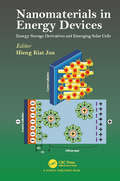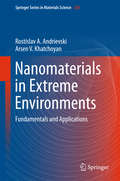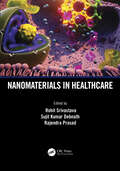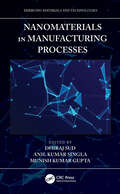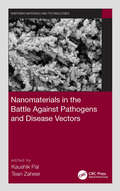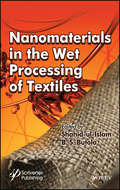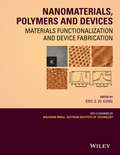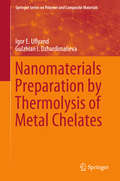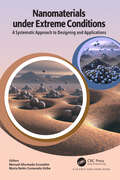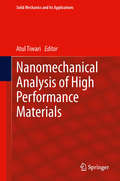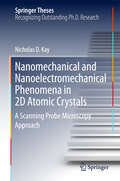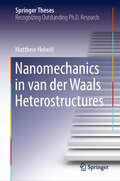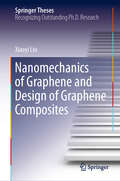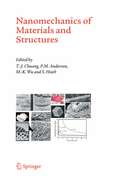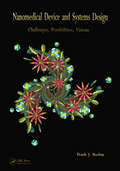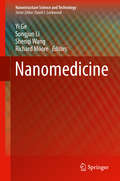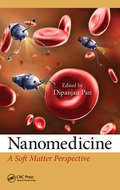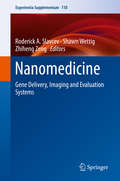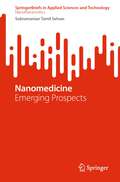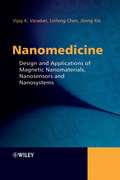- Table View
- List View
Nanomaterials in Energy Devices
by Jun Hieng KiatThis book provides up-to-date information on the application of nano-sized materials in energy devices. A brief overview on the properties of nano-sized materials introduces the readers to the basics of the application of such materials in energy devices. Among the energy devices covered include third generation solar cells, fuel cells, batteries, and supercapacitors. The book places emphasis on the optical, electrical, morphological, surface, and spectroscopic properties of the materials. It contains both experimental as well as theoretical aspects for different types of nano-sized materials, such as nanoparticles, nanowires, thin film, etc.
Nanomaterials in Extreme Environments: Fundamentals and Applications (Springer Series in Materials Science #230)
by Rostislav Andrievski Arsen KhatchoyanThis book focuses on the behaviour of nanomaterials under extreme conditions of high temperature, irradiation by electron/ions and neutrons as well as in mechanical and corrosion extremes. The theoretical approaches and modeling are presented with numerous results of experimental studies. Different processing methods of extreme-tolerant nanomaterials are described. Many application examples from high-temperature technique, nuclear reactors of new generations, aerospace industry, chemical and general engineering, sensor facility, power engineering, electronics, catalysis and medical preparations are also contained. Some unresolved problems are emphasized.
Nanomaterials in Healthcare
by Rohit Srivastava Sujit Kumar Debnath Rajendra PrasadThis cutting-edge reference book discusses the biomedical applications of nanomaterials. It covers different types of nanoparticles, such as polymeric nanoparticles, lipoidal nanoparticles, and metallic nanoparticles. It discusses the current trends and challenges in the development of safe biomedicines. The book reviews FDA-approved medicines, nanohybrid systems for early-stage diagnosis and treatment of diseases, advanced approaches of cost-effective bio-imaging, and theragnostics. It also covers the basic design and fundamental understanding of surface-engineered biomedicine. The book is meant for experts in the healthcare industry as well as post-graduates in biomedical engineering and nanotechnology.
Nanomaterials in Healthcare
This cutting-edge reference book discusses the biomedical applications of nanomaterials. It covers different types of nanoparticles, such as polymeric nanoparticles, lipoidal nanoparticles, and metallic nanoparticles. It discusses the current trends and challenges in the development of safe biomedicines. The book reviews FDA-approved medicines, nanohybrid systems for early-stage diagnosis and treatment of diseases, advanced approaches of cost-effective bio-imaging, and theragnostics. It also covers the basic design and fundamental understanding of surface-engineered biomedicine. The book is meant for experts in the healthcare industry as well as post-graduates in biomedical engineering and nanotechnology.
Nanomaterials in Manufacturing Processes (Emerging Materials and Technologies)
by Dhiraj SudIn the manufacturing sector, nanomaterials offer promising outcomes for cost reduction in production, quality improvement, and minimization of environmental hazards. This book focuses on the application of nanomaterials across a wide range of manufacturing areas, including in paint and coatings, petroleum refining, textile and leather industries, electronics, energy storage devices, electrochemical sensors, as well as in industrial waste treatment. This book: Examines nanofluids and nanocoatings in manufacturing and their characterization. Discusses nanomaterial applications in fabricating lightweight structural components, oil refining, smart leather processing and textile industries, and the construction industry. Highlights the role of 3D printing in realizing the full potential of nanotechnology. Considers synthetic strategies with a focus on greener protocols for the fabrication of nanostructured materials with enhanced properties and better control, including these materials' characterization and significant properties for ensuring smart outputs. Offers a unique perspective on applications in industrial waste recycling and treatment, along with challenges in terms of safety, economics, and sustainability in industrial processes. This work is written for researchers and industry professionals across a variety of engineering disciplines, including materials, manufacturing, process, and industrial engineering.
Nanomaterials in the Battle Against Pathogens and Disease Vectors (Emerging Materials and Technologies)
by Kaushik Pal and Tean ZaheerNanomaterials in the Battle Against Pathogens and Disease Vectors presents an overview of the use of nanotechnology to mitigate pathogens of concern, and is the first book to discuss applications of nanotechnology in the fight against all three major domains of disease-causing pathogens. Bacteria, viruses, and parasites constitute the list of emerging and re-emerging pathogens of high priority. Nanotechnology has proven to be a groundbreaking success in the elimination, targeted toxicity, precise immunogenicity, diagnosis, and imaging of these major pathogens and disease vectors. This text discusses basic concepts and advanced applications for bacteria, viruses, and parasites. It describes the use of metallic and non-metallic nanoparticles and nanotoxicity, as well as presents future applications of nanotechnology in biological applications. This work is ideal for engineers and scientists across the interdisciplinary fields of materials science, biomedical engineering, biotechnology, and others concerned with mitigating the risk and effect of pathogens.
Nanomaterials in the Battle Against Pathogens and Disease Vectors (Emerging Materials and Technologies)
by Kaushik Pal Tean ZaheerNanomaterials in the Battle Against Pathogens and Disease Vectors presents an overview of the use of nanotechnology to mitigate pathogens of concern, and is the first book to discuss applications of nanotechnology in the fight against all three major domains of disease-causing pathogens. Bacteria, viruses, and parasites constitute the list of emerging and re-emerging pathogens of high priority. Nanotechnology has proven to be a groundbreaking success in the elimination, targeted toxicity, precise immunogenicity, diagnosis, and imaging of these major pathogens and disease vectors. This text discusses basic concepts and advanced applications for bacteria, viruses, and parasites. It describes the use of metallic and non-metallic nanoparticles and nanotoxicity, as well as presents future applications of nanotechnology in biological applications. This work is ideal for engineers and scientists across the interdisciplinary fields of materials science, biomedical engineering, biotechnology, and others concerned with mitigating the risk and effect of pathogens.
Nanomaterials in the Wet Processing of Textiles
by Shahid-Ul-Islam B. S. ButolaNanotechnology has attracted attention of textile and polymer scientists and has been playing extraordinary role over the past few decades in the functional finishing of different textile materials. Nanoparticles due to their diverse functions have not only imparted flame retardant, UV-blocking, water repellent, self-cleaning, and antimicrobial properties to the textiles, but also have greater affinity for fabrics leading to an increase in durability of the functions. This book emphasizes recent approaches and strategies that are currently at operation to functionalize both natural and synthetic textile materials using diverse nanoparticles and their composites with polymers. The book concludes by paying attention towards removal of toxic chemicals using state-of-the-art nano-adsorbents. Main Topics 1. Textile dyeing using metallic nanoparticles2. Metal oxide nanoparticles for multifunctional finishing 3. New approaches to produce UV protective textiles4. Polymeric nanocomposites for antimicrobial finishing 5. Self-cleaning of textiles using advanced nanoparticles6. Silver nanoparticles in dyeing and finishing applications7. Zinc Oxide – prospects in textile industry8. Titanium dioxide: Next generation photo-catalysts9. Textile effluent using chitosan nanocomposites 10. Recent advances in remediation of textile effluents using nano-catalysts
Nanomaterials in the Wet Processing of Textiles
by Shahid Ul-Islam B. S. ButolaNanotechnology has attracted attention of textile and polymer scientists and has been playing extraordinary role over the past few decades in the functional finishing of different textile materials. Nanoparticles due to their diverse functions have not only imparted flame retardant, UV-blocking, water repellent, self-cleaning, and antimicrobial properties to the textiles, but also have greater affinity for fabrics leading to an increase in durability of the functions. This book emphasizes recent approaches and strategies that are currently at operation to functionalize both natural and synthetic textile materials using diverse nanoparticles and their composites with polymers. The book concludes by paying attention towards removal of toxic chemicals using state-of-the-art nano-adsorbents. Main Topics 1. Textile dyeing using metallic nanoparticles2. Metal oxide nanoparticles for multifunctional finishing 3. New approaches to produce UV protective textiles4. Polymeric nanocomposites for antimicrobial finishing 5. Self-cleaning of textiles using advanced nanoparticles6. Silver nanoparticles in dyeing and finishing applications7. Zinc Oxide – prospects in textile industry8. Titanium dioxide: Next generation photo-catalysts9. Textile effluent using chitosan nanocomposites 10. Recent advances in remediation of textile effluents using nano-catalysts
Nanomaterials, Polymers and Devices: Materials Functionalization and Device Fabrication
by E. S. W. Kong Wolfgang KnollProviding an eclectic snapshot of the current state of the art and future implications of the field, Nanomaterials, Polymers, and Devices: Materials Functionalization and Device Fabrication presents topics grouped into three categorical focuses: The synthesis, mechanism and functionalization of nanomaterials, such as carbon nanotubes, graphene, silica, and quantum dots Various functional devices which properties and structures are tailored with emphasis on nanofabrication. Among discussed are light emitting diodes, nanophotonic, nano-optical, and photovoltaic devices Nanoelectronic devices, which include semiconductor, nanotube and nanowire-based electronics, single-walled carbon-nanotube based nanoelectronics, as well as thin-film transistors
Nanomaterials, Polymers and Devices: Materials Functionalization and Device Fabrication
by E. S. W. Kong Andreas LendleinProviding an eclectic snapshot of the current state of the art and future implications of the field, Nanomaterials, Polymers, and Devices: Materials Functionalization and Device Fabrication presents topics grouped into three categorical focuses: The synthesis, mechanism and functionalization of nanomaterials, such as carbon nanotubes, graphene, silica, and quantum dots Various functional devices which properties and structures are tailored with emphasis on nanofabrication. Among discussed are light emitting diodes, nanophotonic, nano-optical, and photovoltaic devices Nanoelectronic devices, which include semiconductor, nanotube and nanowire-based electronics, single-walled carbon-nanotube based nanoelectronics, as well as thin-film transistors
Nanomaterials Preparation by Thermolysis of Metal Chelates (Springer Series on Polymer and Composite Materials)
by Igor E. Uflyand Gulzhian I. DzhardimalievaThe book focuses on the thermal transformations of various types of metal chelates, e.g. low molecular weight and polymeric metal chelates, coordination polymers and metal-organic frameworks. It analyzes the major advances and the problems in the preparation of metal oxide materials, mixed-oxide nanocomposites, carbon materials and polymer derived non-oxide nanocomposites by the thermolysis of different metal chelates. It also highlights the influence of the spatial and electronic structure of metal chelates on the mechanism and kinetics of their thermal transformations, and discusses important issues like conjugate thermolysis and computer modelling of the thermolysis process. This book is useful for researchers experienced in thermolysis as well as for young scientists interested in this area of science.
Nanomaterials under Extreme Conditions: A Systematic Approach to Designing and Applications
by Manuel Ahumada Escand MarNanomaterials have supported humankind’s advancement, becoming one of the most important industry sectors, and are expected to rise to the top by 2030. However, significant challenges must be overcome, such as the performance and efficiency of the material under different environmental conditions. This book seeks to promote a critical view on using nanomaterials under extreme conditions found in our body, planet, and outer space. Therefore, nanomaterials are covered from multiple points of view, allowing the reader to get an enriching presentation of current knowledge on nanomaterials, limitations, advancements, and applications under extreme conditions.
Nanomaterials under Extreme Conditions: A Systematic Approach to Designing and Applications
Nanomaterials have supported humankind’s advancement, becoming one of the most important industry sectors, and are expected to rise to the top by 2030. However, significant challenges must be overcome, such as the performance and efficiency of the material under different environmental conditions. This book seeks to promote a critical view on using nanomaterials under extreme conditions found in our body, planet, and outer space. Therefore, nanomaterials are covered from multiple points of view, allowing the reader to get an enriching presentation of current knowledge on nanomaterials, limitations, advancements, and applications under extreme conditions.
Nanomechanical Analysis of High Performance Materials (Solid Mechanics and Its Applications #203)
by Atul TiwariThis book is intended for researchers who are interested in investigating the nanomechanical properties of materials using advanced instrumentation techniques. The chapters of the book are written in an easy-to-follow format, just like solved examples. The book comprehensively covers a broad range of materials such as polymers, ceramics, hybrids, biomaterials, metal oxides, nanoparticles, minerals, carbon nanotubes and welded joints. Each chapter describes the application of techniques on the selected material and also mentions the methodology adopted for the extraction of information from the raw data.This is a unique book in which both equipment manufacturers and equipment users have contributed chapters. Novices will learn the techniques directly from the inventors and senior researchers will gain in-depth information on the new technologies that are suitable for advanced analysis. On the one hand, fundamental concepts that are needed to understand the nanomechanical behavior of materials is included in the introductory part of the book. On the other hand, dedicated chapters describe the utilization of advanced numerical modeling in understanding the properties of complex materials.This book is useful for students and researchers from diverse backgrounds including chemistry, physics, materials science & engineering, biotechnology and biomedical engineering. It is well suited as a textbook for students and as a reference book for researchers.
Nanomechanical and Nanoelectromechanical Phenomena in 2D Atomic Crystals: A Scanning Probe Microscopy Approach (Springer Theses)
by Nicholas D. KayThis thesis introduces a unique approach of applying atomic force microscopy to study the nanoelectromechanical properties of 2D materials, providing high-resolution computer-generated imagery (CGI) and diagrams to aid readers’ understanding and visualization. The isolation of graphene and, shortly after, a host of other 2D materials has attracted a great deal of interest in the scientific community for both their range of extremely desirable and their record-breaking properties. Amongst these properties are some of the highest elastic moduli and tensile strengths ever observed in nature. The work, which was undertaken at Lancaster University’s Physics department in conjunction with the University of Manchester and the National Physical Laboratory, offers a new approach to understanding the nanomechanical and nanoelectromechanical properties of 2D materials by utilising the nanoscale and nanosecond resolution of ultrasonic force and heterodyne force microscopy (UFM and HFM) – both contact mode atomic force microscopy (AFM) techniques. Using this approach and developing several other new techniques the authors succeeded in probing samples’ subsurface and mechanical properties, which would otherwise remain hidden. Lastly, by using a new technique, coined electrostatic heterodyne force microscopy (E-HFM), the authors were able to observe nanoscale electromechanical vibrations with a nanometre and nanosecond resolution, in addition to probing the local electrostatic environment of devices fabricated from 2D materials.
Nanomechanics in van der Waals Heterostructures (Springer Theses)
by Matthew HolwillMicro/nano-mechanical systems are a crucial part of the modern world providing a plethora of sensing and actuation functionalities used in everything from the largest cargo ships to the smallest hand-held electronics; from the most advanced scientific and medical equipment to the simplest household items. Over the past few decades, the processes used to produce these devices have improved, supporting dramatic reductions in size, but there are fundamental limits to this trend that require a new production paradigm.The 2004 discovery of graphene ushered in a new era of condensed matter physics research, that of two-dimensional materials. Being only a few atomic layers thick, this new class of materials exhibit unprecedented mechanical strength and flexibility and can couple to electric, magnetic and optical signals. Additionally, they can be combined to form van der Waals heterostructures in an almost limitless number of ways. They are thus ideal candidates to reduce the size and extend the capabilities of traditional micro/nano-mechanical systems and are poised to redefine the technological sphere.This thesis attempts to develop the framework and protocols required to produce and characterise micro/nano-mechanical devices made from two-dimensional materials. Graphene and its insulating analogue, hexagonal boron nitride, are the most widely studied materials and their heterostructures are used as the test-bed for potential device architectures and capabilities. Interlayer friction, electro-mechanical actuation and surface reconstruction are some of the key phenomena investigated in this work.
Nanomechanics of Graphene and Design of Graphene Composites (Springer Theses)
by Xiaoyi LiuThis book addresses several important issues concerning the nanomechanics of graphene, an area that is vital to a fundamental understanding of graphene deformation, and to the design of graphene-related materials. The content chiefly focuses on the out-of-plane mechanical behaviors of graphene, and their effects on the mechanical properties of graphene composites. In addition, the book puts forward original theoretical mechanical models based on continuum mechanics, discontinuous effects and atomistic simulations. The findings presented here can provide the basis for valuable guidelines on the design and application of graphene and graphene composites in the field of nanomechanics.
Nanomechanics of Materials and Structures
by Tze-Jer Chuang P. M. Anderson M. K. Wu S. HsiehThis book is derived from the proceedings of the International Workshop on Nanomechanics held at Asilomar Conference Grounds in Pacific Grove, California on July 14-17, 2004. Approximately 70 leading experts from academia, government and industrial sectors in semiconductors, computers, communication, information technology, defense, energy, transportation and aerospace attended the Workshop (see the workshop photo taken on July 16, 2004). The main objective was to convene leading researchers in the nanotechnology community to assess the current state-of-the-art and disseminate recent progress, critical issues, barriers to applications, and directions for future research in nanomechanics. Miniaturization of structural components and functional devices such as electronic, optical, mechanical and electric-magnetic parts has been a recent trend, and the pace has accelerated over the past few years. Advances in micromanufacturing, semiconductor processing (e.g., etching, lithography, grafting, etc.), sensors, actuators and microprocessors have opened up a revolutionary path to the development of new technologies such as micro-electro-mechanical systems (MEMS), nano-electro-mechanical systems (NEMS), micro-engines, smart structures, smart controllers, lab-- a-chip devices, and even bio-medical sensing devices which can detect, analyze, decide and activate appropriate functions in real time. The above-mentioned devices, structures, or systems, have one issue in common. In order to perform their assigned functions, they must maintain their structural integrity and be reliable and durable during their entire designed service life. Thus, strength, durability, and time-dependent mechanical property degradation are major concerns for design engineers and device manufacturers, even though the parts are designed for electronic, magnetic, optical or other functions.
Nanomedical Device and Systems Design: Challenges, Possibilities, Visions
by Frank BoehmNanomedical Device and Systems Design: Challenges, Possibilities, Visions serves as a preliminary guide toward the inspiration of specific investigative pathways that may lead to meaningful discourse and significant advances in nanomedicine/nanotechnology. This volume considers the potential of future innovations that will involve nanomedical devic
Nanomedicine: Principles and Perspectives (Nanostructure Science and Technology)
by Yi Ge Songjun Li Shenqi Wang Richard MooreIncreasing demand for and awareness of the applications of nanotechnology in medicine has resulted in the emergence of a new fast-growing multidisciplinary area - nanomedicine. This book offers comprehensive knowledge of and diverse perspectives on nanomedicine through two independent volumes. It aims to bridge the gap between nanotechnology and medicine through contributions by world-renowned experts from wide range of backgrounds including academia, industry, professional consultancy, and government agencies.Each contribution integrates knowledge from a wide range of areas to present the fundamentals of new applications and products of nanomedicine, as well as an outlook for the future. This book can well serve as a reference and guide for students, academics, researchers, scientists, engineers, clinicians, government researchers, and healthcare professionals.
Nanomedicine: A Soft Matter Perspective
by Dipanjan PanThe unprecedented potential of nanotechnology for early detection, diagnosis, and personalized treatment of diseases has found application in every biomedical imaging modality. However, with the increasing concern about the ethical and toxicity issues associated with some "nanoplatforms," biomedical researchers are in pursuit of safer, more precise
Nanomedicine: Gene Delivery, Imaging and Evaluation Systems (Experientia Supplementum #110)
by Roderick A. Slavcev Shawn Wettig Zhiheng ZengThis work was compiled to serve as a convenient source that covers a number of techniques (and details of their use) in the rather large field of nanomedicine, with special attention paid to gene delivery. As principal investigators working in the field of nanomedicine, we sought to put together the most current and relevant topics in gene delivery, imaging and evaluation systems. We expect the work to serve very well for scientists and graduate students in the nanomedicine field.
Nanomedicine: Emerging Prospects (SpringerBriefs in Applied Sciences and Technology)
by Subramanian Tamil SelvanThis book highlights the emerging paradigm of nanomedicine, intersecting two burgeoning fields of nanotechnology and medicine. Numerous publications have appeared in the literature over the years, especially in cancer nanomedicine. In a boarder sense, nanomedicine aims to apply the knowledge and tools of nanotechnology in a mission to diagnose early and prevent or treat diseases using biocompatible nanoparticles (NPs). Current research in nanomedicine and its prospects depend on creating new breakthroughs at the nexus of nanomaterials and biological systems, making use of non-toxic NPs and nano/biomaterials as smart theranostic systems for a variety of diseases including cancer, neurodegenerative, orthopedic, and cardiac diseases. This book provides a review on recent advancements of nanomedicine in the aforementioned emerging areas of nanomedicine.
Nanomedicine: Design and Applications of Magnetic Nanomaterials, Nanosensors and Nanosystems
by Vijay K. Varadan LinFeng Chen Jining XieRecent advances in nanomedicine offer ground-breaking methods for the prevention, diagnosis and treatment of some fatal diseases. Amongst the most promising nanomaterials being developed are magnetic nanomaterials, including magnetic nanoparticles and magnetic nanosensors. Some nanomagnetic medical applications are already commercially available with more set to be released over the coming years. Nanomedicine, Design and Applications of Magnetic Nanomaterials, Nanosensors and Nanosystems presents a comprehensive overview of the biomedical applications of various types of functional magnetic materials. The book provides an introduction to magnetic nanomaterials before systematically discussing the individual materials, their physical and chemical principles, fabrication techniques and biomedical applications. This methodical approach allows this book to be used both as a textbook for beginners to the subject and as a convenient reference for professionals in the field. Discusses magnetic nanoparticles including nanowires, nanotubes, zero-dimensional nanosperes and naturally existing magnetosomes. Examines intrinsically smart magnetic materials and describes their part in the development of biomedical sensors and biochips, which are often used in biomedical tests. Integrates the research efforts of different disciplines – from materials sciences to biology and electrical engineering to medicine – in order to provide a unified and authoritative guide to a richly interdisciplinary field. This volume is of great appeal to students and researchers in the fields of electrical and electronic engineering, biomedical engineering, nanotechnology, materials science, physics, medicine and biology. It is also of interest to practising engineers, materials scientists, chemists and research medical doctors involved in the development of magnetic materials and structures for biomedical applications.
